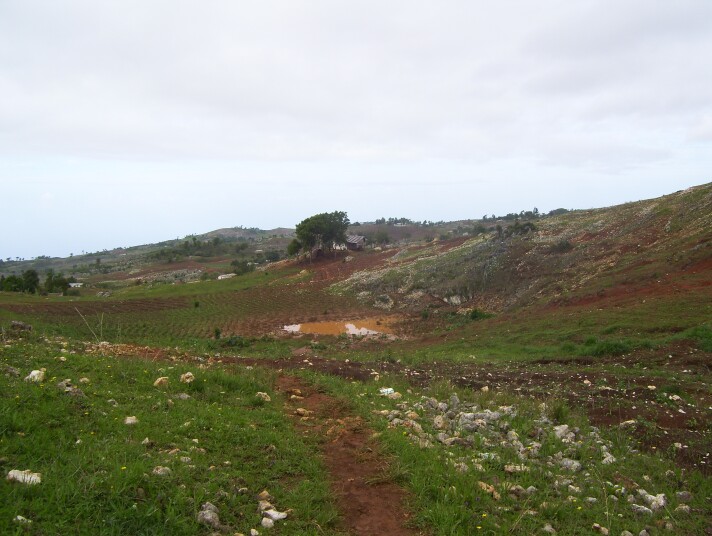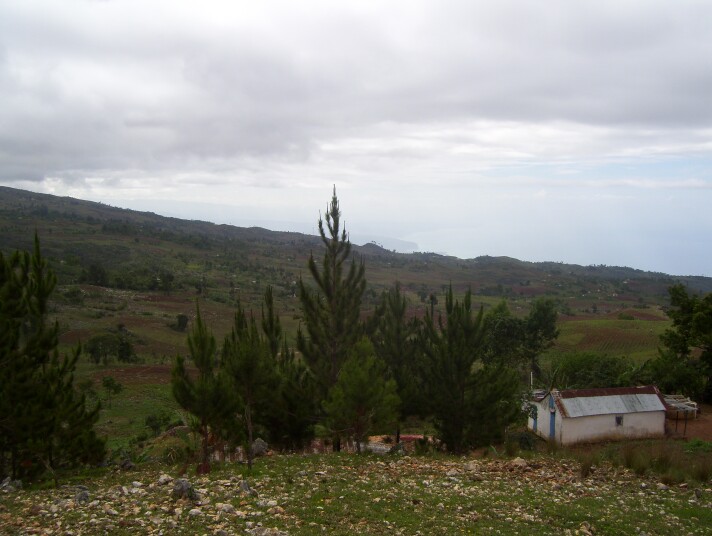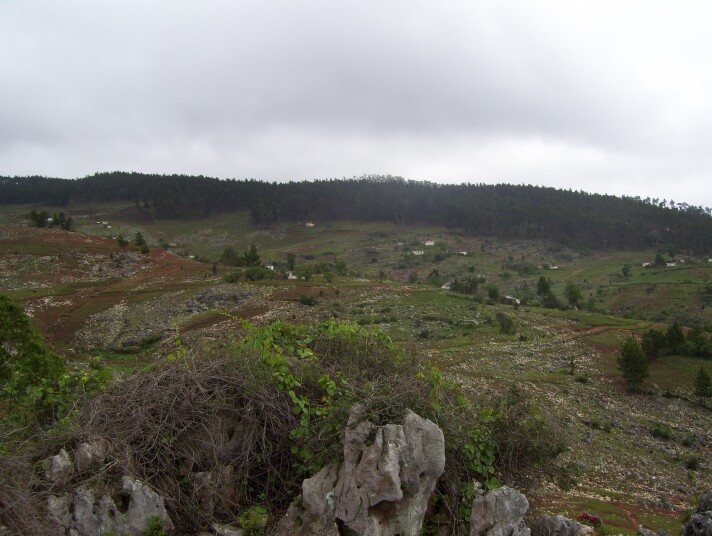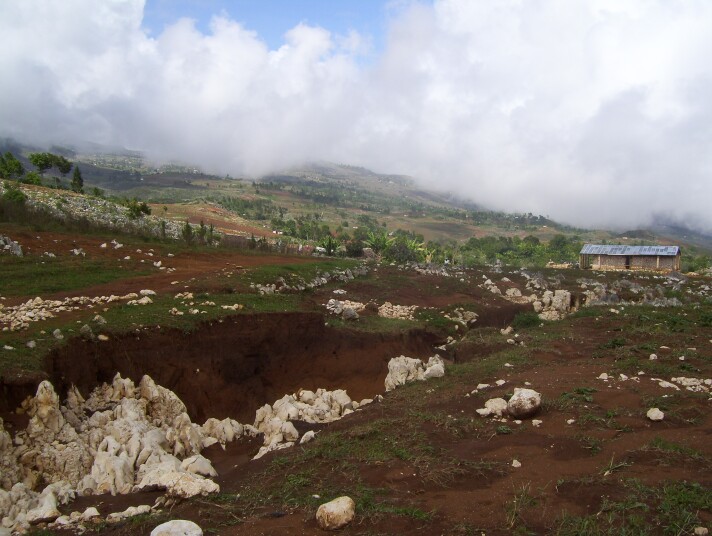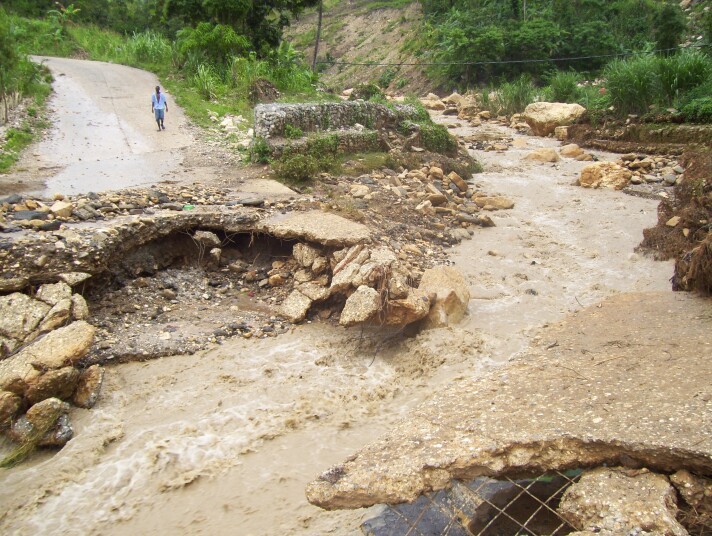We have two credit centers in Mabriyòl, a two-hour ride eastward from Marigo along the main road to Belle Anse and Thiotte. The older office in Jakmèl established Fonkoze’s presence there, several years before the Marigo office opened. Jakmèl is about 45 more minutes to the west, so the existence of a Jakmèl credit center in Mabriyòl reflects how little distance from an office was considered in opening up new regions during Fonkoze’s initial phase of growth.
The two centers were originally a single center, but they flourished so successfully that it became necessary to divide them in two. Mabriyòl is a relatively populous, very rural area in the mountains above Belle Anse. It has a small, one-room health clinic and a public primary school, but little else. The population isn’t concentrated in a center of town, but spread more-or-less evenly across the hillside.
It’s hard for me to get to Mabriyòl. It’s not that it’s especially inaccessible. We have centers that are farther, harder to get to, or both. But it meets on Monday mornings. I try to spend as many Sundays as I can at home in Kaglo, and if I leave by 3:00 AM on Monday, I can get to work around 8:00. But the credit agent who works in Mabriyòl leaves our office at 6:00. Going with him requires me to spend Sunday night in Marigo, something worth doing now and again, but not every week if I don’t have to.
My first visit to Mabriyòl was a happy occasion. We were to improvise a surprise graduation ceremony for two of our borrowers. In this context, “graduation” means moving from solidarity-group credit into individual loans.
It might be hard to appreciate the magnitude of this accomplishment. All solidarity-group loans start at 3000 gourds. Individual loans begin at 50,000 gourds. So the two women who were ready to take this step had managed to borrow and repay about ten loans of increasing size, over the course of five or six years, through floods, droughts, hurricanes, political upheavals, a deteriorating economic landscape, and other impediments. And they did so while living with one of the poorest regions in Haiti on one side of them and a small coastal town with only a small marketplace on the other. They worked and continue to work by traveling back and forth to Port au Prince, carrying produce in one direction, and manufactured goods in the other. Transportation in Haiti is always a challenge, but these women persevered. They are the distribution network that links their very rural community with Port au Prince, Jacmel, and the world generally.
They had just received their new, individual loans, and they are no longer required to come to meetings. They now receive their loans and make their repayments through an entirely different mechanism. But had come to the center meeting because they know they still have a role to play. They are leaders among the Mabriyòl women, both by the example that they offer and the central roles they choose to play. One was the center’s long-time elected chief. Since their center has been struggling with poor attendance and loan delinquency, they aren’t ready to simply turn it over to its new chief.
They both belong to the center in Upper Mabriyòl, and we went to the one in Lower Mabriyòl first. It’s a smaller center, but its troubles are a little more serious. I wanted to have a look. Our first step towards strengthening weak centers was to hold workshops for the centers’ chiefs. We feel, first, that they are the ones best positioned to draw women back to the centers and, second, that once attendance is regular, repayment issues will be easier to solve.
I was especially anxious for this opportunity because I hadn’t been able to attend the workshop for Mabriyòl and neighboring centers. A credit agent who had attended one that I led had had to lead it himself. So I wanted to see whether his workshop would have an effect.
The centerpiece of the workshop was our sense that center meetings were no longer either interesting or fun. They had become long and boring because entirely dominated by the mundane details of giving out loans and collecting repayments. Our twin priorities would be to quicken the repayment process by better organizing it and to create and use space within meetings for activities that are pleasant and useful to center members. The meeting in Mabriyòl had very little reimbursement scheduled, so it would mainly b a chance to see how the center chief and credit agent would use some free time.
I could hardly have been more pleased. The recently elected center chief had gone to the local health clinic to research family planning. She gave a detailed report to members of the options locally available, and then asked her fellow members for their thoughts as to whether to use planning and which ones they would prefer. The lively conversation that ensued lasted about 45 minutes. The women ranged in age from older women claiming to be interested more for their children than for themselves to young women who might have their first child – planned or unplanned – at any time. They all got involved. When the credit agent asked, in closing, what the women thought of the meeting their chief had prepared for them, they answered with loud applause. Though attendance at the meeting had been characteristically poor, more meetings like that might be the best way to draw the women in.
We then moved to Upper Mabriyòl. It meets in a public school building, right next to a Baptist church. The building is under construction. Work was going on even as we met. And the church was hosting a prayer meeting. So almost no one was ready when we arrived. Some members were preparing the prayer meeting, while others were hauling water for the masons working on the school.
We started the meeting with a very short award ceremony. We had come with certificates, congratulating Mabriyòl two graduates. The women accepted them with big smiles to the cheers of the other members present. There was not, however, much else we could do to make the meeting fun. Disbursing new credit for some of the women and completing new loan requests for others took up most of the time.
The latter process takes some time. Borrowers need to be ready for new credit, and the complexities of the special hurricane credit we are now moving out of mean that, even within a solidarity group of five women, we might find some who are ready and others who are not. A few groups had members who don’t yet have the cash on hand to repay their loans completely, but who fear holding their fellow group members back. They were hoping to make withdrawals from their savings accounts to finish repaying their loans, thus releasing themselves and their fellow group members for new credit. They themselves would then wait as they rebuilt their savings through deposits before they ask for new loan, while the other members of their group would be free to move forward.
But making withdrawals is normally difficult for the women. Credit agents are not authorized to make withdrawals in the field. They don’t keep withdrawal slips with them, nor do they keep extra cash on hand. They do not operate like roving tellers. They handle only disbursements and reimbursements of loans and savings deposits for borrowers. For members of a center as far from Marigo as Mabriyòl is access to savings is hard to get. Transportation costs to and from the office to make a withdrawal are high. They stand to lose too much of the money as a transaction cost.
So I did the following: I wrote letters authorizing Fonkoze to make savings withdrawals for reimbursement for each woman who requested one. I asked each of them to sign her letter, and then asked the new center chief to sign as witness. I would make the withdrawals in the office, and then send the receipts back to the center on the credit agent’s next visit. This would accomplish two goals: It would, on the one hand, create an above-board means of enabling women at this distant center to conveniently eliminate their debt. On the other, it would reinforce the center chief’s sense of responsibility within her center. Everyone seemed satisfied. I made the withdrawals and the reimbursements and deposited the authorizing letters in our files when I got back to Marigo.
I would have left the center with a good feeling except for a problem that I could not resolve. I met with one borrower who was the only member of her group to be ready for new credit. The others had not made much of an effort at reimbursing their previous loan at all. She was very anxious to get a new loan, and began asking the other women who were make new loan requests to let her join their group. None were willing. Whether they felt they didn’t know her well enough or knew her too well to be willing to take a risk, I can’t say. In a sense, I had to be pleased at the sign that women wanted to take membership in their groups seriously. On the other, I was sorry to see a borrower in need getting left out. I’m not sure how I can help her any time soon.
That’s pretty much the way of things these days. I spend my days, as a colleague at my home institution put it to me, seeing silver linings in cloud after cloud. Sometimes we feel progress. Our portfolio is now smaller and cleaner than it was when I arrived, but we are very far from being out of the woods.

